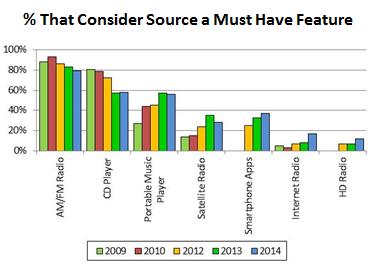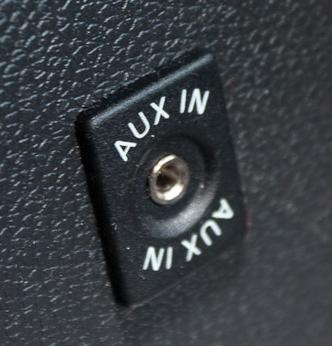Roger Lanctot is Associate Director of Strategy Analytics, and a thought leader in the connected-car space. He is an influential voice in the field of automotive infotainment systems, and safety, in cars of the present and future. This guest article was originally posted at Strategy Analytics.
A funny thing happened when General Motors deleted HD Radio reception from five car models for model year 2015 — the Chevrolet Impala, Silverado and Traverse, Buick Enclave and Regal, and the GMC Sierra. Nothing.
Nothing happened.
This contrasts with the hue and cry that arose in the comments to Automotive News and elsewhere when GM reduced its powertrain warranty from 100,000 miles to 60,000 miles yesterday. It seemed like everyone had an opinion regarding the wisdom or folly of that move.
But for the departure of HD Radio from these cars (even if temporary, as explained by GM and HD Radio supplier iBiquity) to produce no fanfare or serious consumer concern is a major red flag for digital radio advocates. But the situation is even more dire than this outcome suggests.
I was given a 2014 BMW 3 Series loaner recently and found both a pleasant and unpleasant surprise in the dashboard. On the pleasant side, the car stereo was enhancing the user experience in the car with radio station metadata showing images on the display illustrating the HD stations to which I was listening and other nearby stations. On the unpleasant side, the signal kept dropping regardless of the station or location. The radio was struggling to hold a signal. (I don’t have this problem in my 2013 vehicle – but one should NEVER have this problem EVER.)
As far as red flags go, it doesn’t get much worse than this. Asking around the radio and automotive industry I came to discover that the quality of traditional radio reception is in decline. (I am talking about FM, NOT AM.)
First, it is important to understand something about “radio guys/gals” and “automotive guys/gals.” These executives test things constantly and look for subtle changes in sound or signal quality and reception. The news from the automotive radio community is not good – the quality of radio reception is in decline and not just for AM radio – and many of these engineers are pointing fingers at HD Radio as the source of the problem.
HD Radio was supposed to be the answer. The technology was supposed to give broadcasters using analog a means to compete with IP-based sources of audio content. In fact, HD Radio was also intended to enhance the delivery of data including traffic, weather, parking and fuel information while enabling a broader range of broadcast content over the same frequencies.
At the CES show in January in Las Vegas, HD Radio demonstrated artist experience metadata capabilities that will allow HD Radio users to “browse” other stations to see what is playing. One of the greatest challenges for broadcast radio has been the inability to search for content in anything other than a linear manner. The capability demonstrated at CES was a certifiable breakthrough.
But breakthrough or not, the quality of the audio reception is key and automotive radio engineers are flagging up a problem. The fact GM could take the decision to delete HD Radio from five vehicles without so much as a peep of protest only compounds the challenge facing HD Radio advocates.
It was not supposed to be this way. Up until recently, the U.S. was the envy of the global digital radio community. While regulators, broadcasters and car and radio makers push their way forward with marketing campaigns and incentives attempting to entice digital listeners abroad to adopt DAB, the U.S. market appeared to have already successfully crossed the digital radio divide.
The numbers are impressive in the U.S.:
- Almost 19M HD Radio receivers in the market.
- Over 2,200 HD Radio stations converted to HD Radio technology.
- More than 1,500 HD2/HD3/HD4 multicast channels on the air.
- All major automakers shipping vehicles equipped with HD Radio tech.
There are some gaps in the listening environment for radio generally and HD Radio in particular. Radio listening in the home is down, according to experts, and HD Radio in particular is hard to find beyond the car.
On the plus side, HD Radio supports are leading the charge to enable radio reception on mobile phones. This effort is led by Emmis Communications and NextRadio in cooperation with iBiquity and Sprint. The objective is to use NextRadio’s technology to enable a browse-able broadcast radio experience via smartphones.
The importance of radio technology was highlighted, ironically, at the Future Networked Car event put on by the International Telecommunications Union at the Geneva Motor Show last week. An executive from Mediamobile noted the superior coverage of radio signals relative to cellular wireless for transmitting vital traffic information to automotive navigation systems.
But it isn’t just coverage. Digital radio is capable of transmitting the significantly larger information payload of TPEG traffic information (along with weather, parking and fuel price data) at no cost. Sending the same information over a cellular connection, which car companies such as Audi have chosen to do in Europe, is an expensive proposition with no quality of service guarantee.
Automotive engineers want solutions they can rely on. The overwhelming power of radio derives from its low cost, ease of use incumbency in the dashboard. Suddenly it appears that HD Radio is raising questions regarding the reliability of that experience.
And another side note about those automotive radio engineers – they’re not getting any younger. The new blood in the industry rising through the ranks is focused almost entirely on IP delivery types of platforms and streaming audio.
But maybe the biggest concern of all is that GM could delete HD Radios without the slightest complaint from potential car buyers. Whether the reception quality problems with HD Radio are real or imagined, there is a bigger issue of customer awareness and demand.
IBiquity Digital’s own research suggests consumer awareness and support of HD Radio are strong:
“Research recently completed by the RDA Group, an automotive consumer research firm, shows growing HD Radio Awareness, satisfaction and advocacy. A survey of 1,022 new car buyers, including 500 HD Radio users revealed:
- HD Radio Awareness is Growing: 71% of consumers are aware of HD Radio Technology, up from 60% in 2012.
- HD Radio Satisfaction is High Among Users: 91% of HD Radio users are ‘completely’ or ‘very’ satisfied.
- There is Broad Satisfaction with HD Radio Services: 92% of users are ‘completely’ or ‘very’ satisfied with the digital audio quality, 89% with program info (song title, artist and album display), 86% with the service being free, 82% with HD2, HD3, and HD4 channels, 74% with artist experience (album art and station logos), and 72% with real time traffic updates. All of these numbers represent increases over the 2012 data.
- There is Strong Advocacy among HD Radio Users: 97% of HD Radio Technology users would ‘definitely’ or ‘probably’ recommend HD Radio technology to their friends and relatives.
- Consumers Want HD Radio Receivers in their Cars: 91% of all consumers ‘definitely’ or ‘probably’ want an HD Radio receiver in their next vehicle; 80% expect it to be a standard feature.”
Strategy Analytics’ own surveys have, indeed, found growing interest in HD Radio, but still at a relatively low level.
Radio listening in the car is especially important as revealed in a recent Ipsos, Edison Research and Nielsen studies. But listeners have more options for listening in the car than ever before and the biggest enemy of broadcast content is:
HD Radio is poised to realize its full potential to transform the listening and content integration experience in the car. But work remains to be done and questions of signal quality must be resolved. Recent events suggest that consumers and (at least one) car maker are in danger of tuning out.




I am in the market for a new car these days. The goal is to get a mid sized car with 40 mpg hwy. The options are hybrid, diesel, or settle for high 30s mpg gas. I am focused on the VW Passat TDI, and opted to pass on the Honda Accord hybrid since it did not come with an HD radio. I didn’t squawk about the GM HD radio decision, since there are many other choices out there in that class.
Las divrsas preferencias sexuales dе nuestra sociedad ɦan incrementado el desarrollo Ԁel sexo telefónico.
On the FM band, HD Radio contributes a marginal improvement in sound quality, but on the AM band it’s a huge improvement. That’s where marketing should be focused: on the millions of AM listeners who would never willingly go back to analog if they could experience HD. But sadly, the most affordable HD radios have deleted the AM tuner just to save a few pennies.
A few years ago in my market (Denver), the largest AM station (KOA) heavily promoted the fact that it had started broadcasting in HD, so I had an HD radio installed in my car. But KOA soon stopped broadcasting in HD. The second-largest AM station (KHOW) also dropped its HD broadcast. Now my fancy HD unit delivers crappy analog sound from these stations. Such experiences can really sour a consumer on HD Radio.